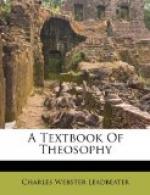We may presume that when this outpouring of life originally came forth from the Deity, at some level altogether beyond our power of cognition, it may perhaps have been homogeneous; but when it first comes within practical cognizance, when it is itself in the intuitional world, but is ensouling bodies made of the matter of the higher mental world, it is already not one huge world-soul but many souls. Let us suppose a homogeneous outpouring, which may be considered as one vast soul, at one end of the scale; at the other, when humanity is reached, we find that one vast soul broken up into millions of the comparatively little souls of individual men. At any stage between these two extremes we find an intermediate condition, the immense world-soul already subdivided, but not to the utmost limit of possible subdivision.
Each man is a soul, but not each animal or each plant. Man, as a soul, can manifest through only one body at a time in the physical world, whereas one animal soul manifests simultaneously through a number of animal bodies, one plant soul through a number of separate plants. A lion, for example, is not a permanently separate entity in the same way as a man is. When the man dies—that is, when he as a soul lays aside his physical body—he remains himself exactly as he was before, an entity separate from all other entities. When the lion dies, that which has been the separate soul of him is poured back into the mass from which it came—a mass which is at the same time providing the souls for many other lions. To such a mass we give the name of “group-soul”.
To such a group-soul is attached a considerable number of lion bodies—let us say a hundred. Each of those bodies while it lives has its hundredth part of the group-soul attached to it, and for the time being this is apparently quite separate, so that the lion is as much an individual during his physical life as the man; but he is not a permanent individual. When he dies the soul of him flows back into the group-soul to which it belongs, and that identical lion-soul cannot be separated again from the group.
A useful analogy may help comprehension. Imagine the group-soul to be represented by the water in a bucket, and the hundred lion bodies by a hundred tumblers. As each tumbler is dipped into the bucket it takes out from it a tumblerful of water (the separate soul). That water for the time being takes the shape of the vehicle which it fills, and is temporarily separate from the water which remains in the bucket, and from the water in the other tumblers.
Now put into each of the hundred tumblers some kind of colouring matter or some kind of flavouring. That will represent the qualities developed by its experiences in the separate soul of the lion during its lifetime. Pour back the water from the tumbler into the bucket; that represents the death of the lion. The colouring matter or the flavouring will be distributed through the whole of the water in the bucket, but will be a much fainter colouring, a much less pronounced flavour when thus distributed than it was when confined in one tumbler. The qualities developed by the experience of one lion attached to that group-soul are therefore shared by the entire group-soul, but in a much lower degree.




